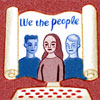
Law Day: Courts, Justice, Freedom
Lively, civil discussion is the hallmark of Law Day, which is celebrated every year on May 1 and throughout the month. These materials for a classroom activity or courtroom event set the stage for creative presentations and analysis of landmark Supreme Court decisions. The case summaries highlight the Law Day theme as examples of how courts protect the rule of law and the rights of minorities, including those who express unpopular views or religious practices; and those who have been excluded from the judicial process or from public schools.
About These Resources
The program provides background for teachers and resources for students based on the National Social Studies Standards.
Program Description: Participants present landmark Supreme Court cases and explore questions about Courts, Justice, and Freedom in the case summaries provided.
Participants: 9th-12th grade students (or teachers for professional development programs)
Format: Classroom or Courtroom Civil Discussion
How to Use These Resources
In Advance
- Teachers/lawyers and students read the Case Summaries and Questions.
- Participants prepare presentations of the facts and summaries for selected cases in the classroom or courtroom.
In the Classroom or Courtroom
Teachers/lawyers, and/or judges facilitate the following activities:
- Presentation: Rule of Law Overview
- Interactive warm-up: Opening Discussion and Talking Points
- Teams of students present: Case Summaries and Discussion Questions
- Wrap-up: Questions for Understanding
- Program Times: 50-minute class period; 90-minute courtroom program.
Timing depends on the number of cases selected. Presentations maybe made by any combination of teachers, lawyers, and/or students and student teams, followed by the discussion questions included in the wrap-up.
- Preparation Times:
- Teachers/Lawyers/Judges: 30 minutes reading
- Students: 60-90 minutes reading and preparing presentations, depending on the number of cases and the method of presentation selected.
- Courthouse Venue: If the teacher would like to have a federal judge preside over the presentations, use the court locator to find the nearest local courthouse.
Resources: Case Summaries and Questions
- Express Unpopular Views:
Snyder v. Phelps (military funeral protests)
Johnson v. Texas (flag burning) - Participate in the Judicial Process:
Batson v. Kentucky (race and jury selection)
J.E.B. v. Alabama (gender and jury selection) - Exercise Religious Practices:
Church of the Lukumi-Babalu Aye, Inc. v. City of Hialeah (controversial religious practices)
Wisconsin v. Yoder (compulsory education law and exercise of religion) - Access to Education:
Plyer v. Doe (immigrant children)
Brown v. Board of Education (separate is not equal)
Cooper v. Aaron (implementing desegregation)